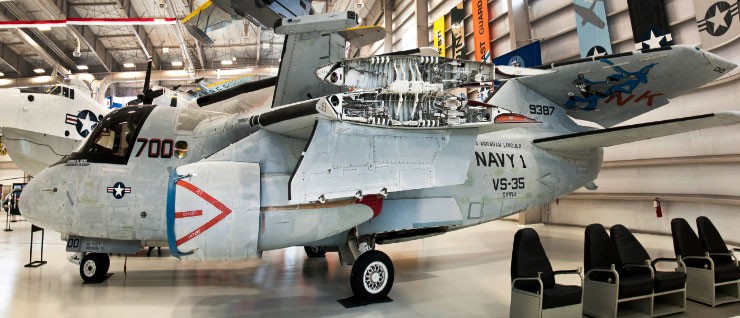S-3B Viking "Navy One"

Low (PNG, 319x319px, 125KB)
Med (JPEG, 1280x1280px, 80KB)
The multi-mission S-3 Viking carrier-based anti-submarine warfare aircraft was the only jet aircraft operated in that mission for over 30 years. With a pilot and three sensor operators, it was known to fleet crews as the "Hoover," owing to the vacuum sound of its engines, and operated day and night from big-deck carriers to track Soviet submarines during the Cold War. This particular Viking carried President George W. Bush as a passenger in 2003 to the aircraft carrier Abraham Lincoln (CVN-72), and during that time was designated "Navy One."
The last carrier-based aircraft designed for anti-submarine warfare, the Lockheed S-3 Viking was introduced into fleet service on 20 February 1974. The Viking boasted the latest in radar, sonar, and magnetic anomaly detection (MAD) gear as well as torpedoes and sonobuoys. A total of 187 S-3As were delivered to the fleet. In addition to service in anti-submarine squadrons, the aircraft was modified to fill a variety of other roles, including use in aerial refueling and as a carrier on-board delivery (COD) platform.
Beginning in 1987, 132 of the original batch of S-3As received equipment upgrades and modified weapons systems. With the end of the Cold War, these S-3B versions of the Viking shifted their focus away from anti-submarine warfare to use as surveillance and precision-targeting platforms armed with an array of modern weapons, including Harpoon and Maverick missiles and the AGM-84 Standoff Land Attack Missile Extended Range (SLAM-ER) missile. In addition, with the retirement of the KA-6D Intruder it assumed the role as the carrier's primary overhead/mission tanker.
Phased withdrawal of the S-3B Viking from service began in 2003 and was complete in 2009. Accepted by the Navy in May 1974, the Museum's Viking (Bureau Number 159387), delivered as an S-3A before a weapon systems improvement program resulted in redesignation as an S-3B, served for 29 years, flying primarily with Pacific Fleet squadrons. During its final tour with Sea Control Squadron (VS) 35, the aircraft logged combat missions over Iraq from the deck of the aircraft carrier Abraham Lincoln (CVN-72) during her epic ten-month deployment, the longest ever for a nuclear carrier. On 1 May 2003, the aircraft made history when President George W. Bush was a passenger during a carrier arrested landing on board the flattop. In so doing he became the first sitting chief executive to trap on board an aircraft carrier. As is customary, during the time President Bush was aboard the aircraft it was known as "Navy One."
SPECIFICATIONS
| Manufacturer: | Lockheed-Martin Aeronautics |
| Type: | anti-submarine warfare (ASW) |
| Crew: | Pilot, COTAC (Naval Flight Officer), Acoustic Sensor Operator (AW), Non-Acoustic Sensor Operator (AW) |
| Powerplant: | Two 9,275 lb. static thrust General Electric TF-34-GE-400B turbofans |
| Dimensions: | Length: 53 ft., 4 in. |
| Weight: | Empty: 26,650 lb. |
| Performance: | Max Speed: 518 mph at 25,000 ft. |
| Armament: | Up to 3,958 lb. ordnance, including AGM-84 Harpoon, AGM-65 Maverick and AGM-84 SLAM and SLAM(ER) missiles, torpedoes, rockets and bombs |
- Aviation
- Photograph
- Image (gif, jpg, tiff)


